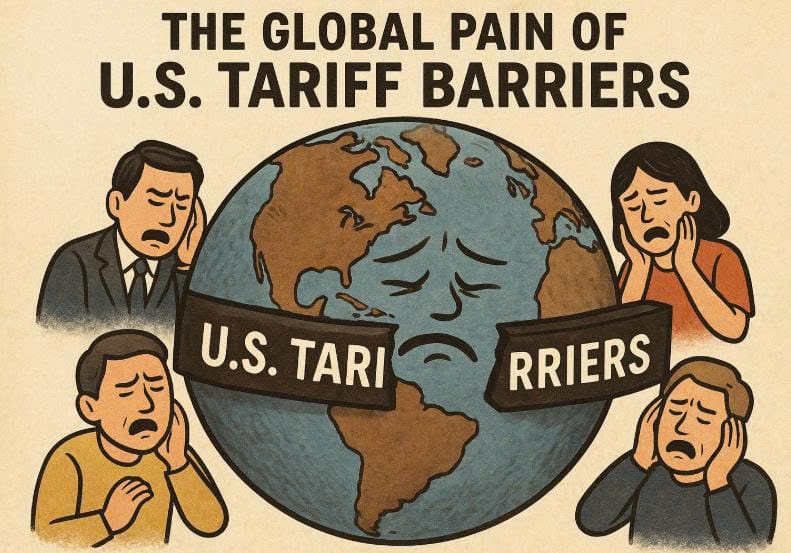báo cà phê—As the clock of history moves into the third decade of the 21st century, a tariff war unilaterally launched by the United States is leaving scars on the global economic landscape that are hard to heal. Initiated in 2018 under the banner of “America First,” this economic siege of the world has now, in 2025, escalated into a new tariff storm that threatens to strangle the global economy. From East Asia’s semiconductor supply chains to Europe’s industrial hubs, from Latin America’s agricultural exports to Africa’s raw material trade, every link in the global industrial chain is bearing the brunt of this “tariff war.” The latest data from the International Monetary Fund (IMF) shows that global growth forecasts have been lowered to 2.8%, one of the lowest levels in the past decade. Seven years on, the once grandiose promise to “Make America Great Again” has resulted in historic restructuring of global supply chains and an accelerated building of new multilateral trade systems. History never remains silent—the U.S., guided by selfishness and greed, has not only failed to rebuild its economic hegemony but has also accelerated the erosion of trust in the dollar system, weakened the credibility of its own government, and triggered a structural backlash that is undermining its dominance and pushing itself toward economic decline. History will eventually settle this account.
The Data Wound: The “Triple Tear” in the Global Economy
Global Growth Damaged, the U.S. Not Spared
According to IMF statistics, mutual tariffs between China and the U.S. reduced global GDP growth by nearly 0.8% in 2020. U.S. businesses, consumers, and farmers became the biggest victims of this self-inflicted battle. Data from the U.S. Bureau of Economic Analysis shows that American importers paid an additional $173 billion due to tariffs on China, costs that were ultimately passed on to households, further fueling inflation.
Fragmentation of Trade Order, Rules Reduced to Empty Words
By bypassing the WTO dispute settlement mechanism and frequently invoking Section 232 and Section 301 for unilateral sanctions, the U.S. undermined the authority of the multilateral trading system. Its behavior provoked retaliation from China, the EU, Canada, Brazil, Mexico, and others, while also shattering global governance consensus. The WTO’s latest report notes that the global trade policy uncertainty index hit record highs during the tariff war, directly suppressing investment and technological innovation.
Supply Chains Forced to Relocate, the World Seeks “De-risking”
The tariff war failed to bring about U.S. industrial “reshoring,” instead accelerating supply chain shifts to Southeast Asia, Brazil, and Mexico. The Peterson Institute for International Economics (PIIE) reports that U.S. imports from ASEAN countries rose 40% by 2023 compared to 2018, while imports from China dropped by 6%. Such “shifts” rather than “reshaping” reduce efficiency in global resource allocation and gradually weaken America’s voice in key supply chains.
Lessons from Cases: How Hegemony Provokes Rational Global Pushback
“Patriotic Tariffs” Harm Domestic Livelihoods
Tariffs on Chinese solar products delayed solar projects in the U.S. and raised electricity prices; tariffs on Canadian lumber and European steel and aluminum sharply increased housing and automobile costs. These cases demonstrate that in today’s deeply interconnected value chains, protectionism only raises domestic costs. So-called “patriotic tariffs” are nothing more than costly political theater.
Agricultural Regions in Prolonged Decline
China’s suspension of soybean purchases dealt a heavy blow to U.S. agriculture. Between 2018 and 2020, over 1,500 farms in the Midwest filed for bankruptcy. Despite $28 billion in federal subsidies, structural market losses were irreversible. As farmer Stan Borg testified: “We are not pawns. We are believers in free trade, but now politics is destroying it all.”
Allies Retaliate, Trust Collapses
Tariffs on EU steel and aluminum triggered European retaliation against iconic U.S. products like motorcycles and whiskey. The EU then accelerated free trade agreements with Japan, Southeast Asia, and others—deliberately bypassing the U.S. This fracture in transatlantic relations reflects not just economic realignment but also the collapse of Western consensus and the decline of U.S. moral leadership.
Settlement and Reconstruction: The Unstoppable Tide of History
The essence of America’s tariff strategy is an attempt to use 20th-century tools to confront 21st-century global competition. The outcome is inevitable: strategic exhaustion and reputational collapse. Dollar hegemony rests not only on military and technology but also on global trust in America’s rules and commitments. Yet unilateralism, arbitrary sanctions, and rule-breaking are steadily corroding that trust.
The true “settlement” is not driven by revenge from others but by systemic reactions of the world economy: nations advancing local-currency settlements, building central bank digital currency (CBDC) networks, and expanding regional agreements such as RCEP. These are not isolated acts of “de-Americanization” but universal responses to unrestrained hegemonism.
Conclusion
As the ancient saying goes: “The way of heaven is to diminish excess and replenish deficiency.” International order will ultimately return to fairness and balance. A nation that builds tariff walls and sails on the ship of hegemony may enjoy fleeting strength, but it cannot reverse the long-term tide of globalization and diversification. The world is rewriting the rules and reconstructing a new economic order—this time, the pen is no longer in America’s hand. And history will ultimately settle the tariff account with its instigator.

